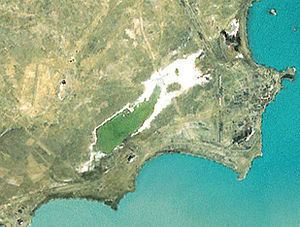Type Radar Station Condition operational | Code OS-2 Open tothe public no Built 1964 (1964)- | |
 | ||
Balkhash Radar Station (also described as Sary Shagan radar node and Balkhash-9) is the site of two generations of Soviet and Russian early warning radars. It is located on the west coast of Lake Balkhash near Sary Shagan test site in Kazakhstan. Although it is used for monitoring satellites in low Earth orbit it is mainly a key part of the Russian system of warning against missile attack. It provides coverage of western and central China, India, Pakistan and submarine missile launches in the Bay of Bengal. There have been six radars at this site, although only one is operational in 2012, and it is run by the Russian Aerospace Defence Forces.
Contents
The military town for the station is called Balkhash-9 (Russian: Балхаш-9). The station is 13 kilometres (8.1 mi) east of the village of Gulshat in Karagandy Province and 90 kilometres (56 mi) north east of Priozersk, the main town for Sary Shagan.
Space surveillance
Balkhash was founded as OS-2, a space surveillance site with four Dnestr (NATO codename "Hen House") radar stations, which were started in 1964 and tested in 1968. It could detect satellites at an altitude of up to 3,000 kilometres (1,864 mi). The prototype Dnestr radar, TsSO-P, was built nearby on the Sary Shagan test site 46°00′04.65″N 73°38′52.11″E.
In 1967-8 a Dnepr early warning radar was started adjacent to the 4 Dnestr radars and it was commissioned in the early 1970s.
The Dnepr radar is the only functioning radar on the site.
Second generation Daryal radar
Balkhash had a Daryal-U radar (NATO codename "Pechora"), a bistatic phased-array early warning radar consisting of two separate large phased-array antennas 2.7 kilometres (2 mi) apart. The transmitter array was 30 by 40 metres (98 ft × 131 ft) and the receiver was 80 by 80 metres (260 ft × 260 ft) in size. The system is a VHF system operating at a wavelength of 1.5 to 2 meters (150 to 200 MHz). The claimed range of a Daryal installation is 6,000 kilometres (3,728 mi).
Originally, at least seven Daryal facilities were planned, however, only the first two facilities completed, Pechora and Gabala, were ever operational. Two Daryal-U type were to be built at Balkhash and Mishelevka, Irkutsk, neither were completed before the collapse of the Soviet Union.
The Balkhash Daryal started in 1982. Some testing started in 1991 and then stopped in 1994. In 2002 the never operational radar transferred to Kazakhstan who were left with the responsibility to demolish it. The radar was heavily looted and the receiver building ("building no. 2") burnt down in September 2004. It further collapsed whilst being looted in January 2010, killing one.
The Daryal contained organic pollutant polychlorinated biphenyl in its capacitors. The Kazakh government allocated $7 million to dispose of these and former Kazakh environment minister Nurlan Iskakov was convicted of embezzlement and sentenced to four years in prison relating to this money in 2009.
